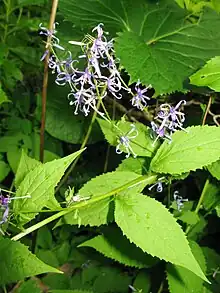Asyneuma
Asyneuma is a genus of flowering plants in the bellflower family, Campanulaceae. They are native to North Africa and Eurasia.[2] Many are endemic to Turkey.[3][4] Plants of the genus may be known commonly as harebells, but this name can also apply to the entire family.[5] There are up to about 33 species.[2][6]
| Asyneuma | |
|---|---|
 | |
| Asyneuma japonicum | |
| Scientific classification | |
| Kingdom: | Plantae |
| Clade: | Tracheophytes |
| Clade: | Angiosperms |
| Clade: | Eudicots |
| Clade: | Asterids |
| Order: | Asterales |
| Family: | Campanulaceae |
| Subfamily: | Campanuloideae |
| Genus: | Asyneuma Griseb. & Schenk |
| Synonyms[1] | |
| |
Characters used to identify Asyneuma species include a generally wheel-shaped (rotate) corolla with the petals fused at the bases and spreading outward into very narrow lobes, lacking or rudimentary appendages on the calyx, a stigma with 2 to 4 lobes, and an oblong or roughly spherical fruit capsule that breaks open via pores on the sides.[7] These characters are not always helpful in distinguishing Asyneuma from the closely related genus Campanula, because authors disagree on which character is more important: the extent to which the flower petals are joined versus the position of the pores on the fruit capsule. Molecular data has been required to determine the best genus in which to place certain species.[8]
Species include:
- Asyneuma amplexicaule (Willd.) Hand.-Mazz. - Turkey, Iran, Iraq, Caucasus
- Asyneuma anthericoides (Janka) Bornm. - Balkans
- Asyneuma argutum (Regel) Bornm. - Central Asia
- Asyneuma babadaghense Yildiz & Kit Tan - Turkey
- Asyneuma campanuloides (M.Bieb. ex Sims) Bornm. - Caucasus
- Asyneuma canescens (Waldst. & Kit.) Griseb. & Schenk - Balkans, Ukraine
- Asyneuma chinense D.Y.Hong - Guangxi, Guizhou, Hubei, Sichuan, Yunnan
- Asyneuma compactum Damboldt - Turkey
- Asyneuma davisianum Yildiz & Kit Tan - Turkey
- Asyneuma ekimianum Yildiz & Kit Tan - Turkey
- Asyneuma filipes (Nábelek) Damboldt - Turkey, Iraq
- Asyneuma fulgens (Wall.) Briq. - Indian Subcontinent, Tibet, Myanmar
- Asyneuma giganteum (Boiss.) Bornm. - Greek Islands
- Asyneuma ilgazense Yildiz & Kit Tan - Turkey
- Asyneuma isauricum Contandr., Quézel & Pamukç - Turkey
- Asyneuma japonicum (Miq.) Briq. - Japan, Korea, Manchuria, Russian Far East
- Asyneuma junceum Parolly - Turkey
- Asyneuma limonifolium (L.) Janch. - Balkans, Italy, Turkey
- Asyneuma linifolium (Boiss. & Heldr.) Bornm. - Turkey
- Asyneuma lobelioides (Willd.) Hand.-Mazz. - Turkey, Caucasus
- Asyneuma lycium (Boiss.) Bornm. - Turkey
- Asyneuma macrodon (Boiss. & Hausskn.) Bornm. - Iran
- Asyneuma michauxioides (Boiss.) Damboldt - Turkey
- Asyneuma persicum (A.DC.) Bornm. - Turkey, Iraq, Iran
- Asyneuma pulchellum (Fisch. & C.A.Mey.) Bornm.- Turkey, Iraq, Iran, Caucasus
- Asyneuma pulvinatum P.H.Davis - Turkey
- Asyneuma rigidum (Willd.) Grossh. - Algeria, Caucasus, Turkey, Iran, Iraq, Lebanon, Sinai, Syria
- Asyneuma thomsonii (C.B.Clarke) Bornm. - western Himalayas
- Asyneuma trichocalycinum (Boiss.) Bornm. - Turkey
- Asyneuma trichostegium (Boiss.) Bornm. - Turkey
- Asyneuma virgatum (Labill.) Bornm. - Greek Islands, Turkey, Iran, Caucasus, Syria
References
- Kew World Checklist of Selected Plant Families
- Asyneuma. Flora of China.
- Alçitepe, E. (2008). Morphological, anatomical and palynological studies on Asyneuma michauxioides (Campanulaceae). Biologia 63(3), 338-42.
- Tan, K. and B. Yildiz. (1988). New Asyneuma (Campanulaceae) taxa from Turkey. Willdenowia 18(1), 67-80.
- Asyneuma. Integrated Taxonomic Information System (ITIS).
- Asyneuma. The Plant List.
- Parolly, G. (2000). Notes on two neglected Turkish Asyneuma taxa (Campanulaceae). Willdenowia 30(1), 67-75.
- Stefanovic, S. and D. Lakusic. (2009). Molecular reappraisal confirms that the Campanula trichocalycina-pichleri complex belongs to Asyneuma (Campanulaceae). Bot Serb 33, 21-31.